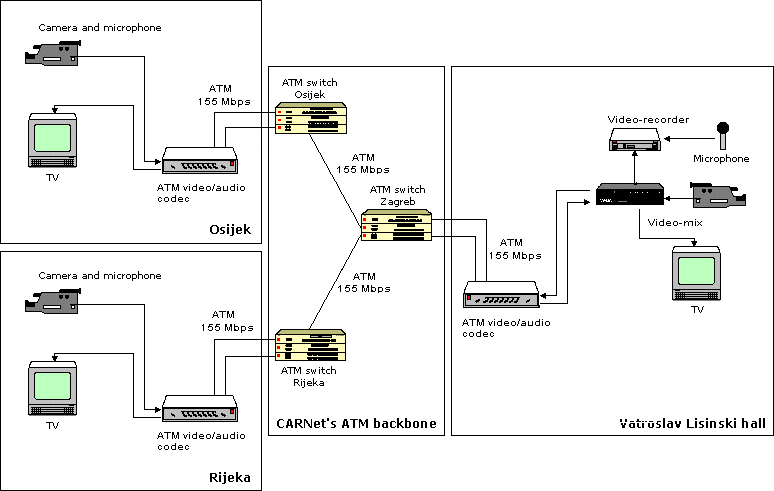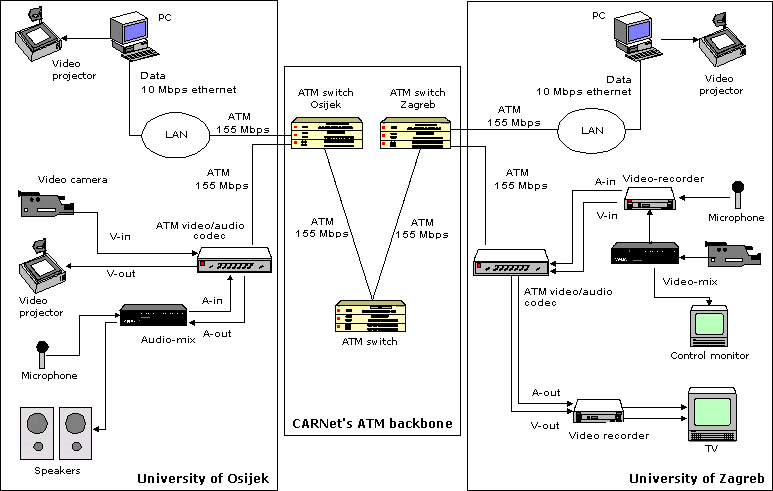Applications of Broadband Digital Networks
Igor Tesija, Ruzica Vucic, Andjelko Zigman
CARNet, Croatia

CARNet, Croatia

Asynchronous Transfer Mode (ATM) equipment that made all of these experiments possible are; multi-mode optical cables with SC connectors, ATM switches (Cisco LightStream - supports up to 16 ATM lines of 155 Mbps data speed), a Stackable Video ATM Codecs (K-Net Cellstack Video), etc.
First demonstration of ATM technology in Croatia was held by CARNet during the exhibition INFO '95 in Zagreb. On that occasion video conferencing between two users on different LAN-s was shown for the first time. The connection was established between the hall in Faculty of electrical engineering and computing in Zagreb and the stand in the exhibition center. Four Sun SparcStation20 workstations with video cards, cameras, microphones and Sun ShowMe conferencing software were used as video conferencing terminals. Three workstations were at the exhibition center and one was at the faculty hall. Digitized audio and video signals were transferred over ATM network allowing spectators in the exhibition center to see happenings in the faculty hall and vice versa (figure 1).

Figure 1. Video conferencing part of CARNet's system used for Info '95 exhibition
Even though the quality of video and audio signal were relatively bad in regard to the quality that ATM technology can provide and compared to our later projects this demonstration led the ATM technology out of laboratories for the first time. That kinds of “virtual windows” in the exhibition center, through which is possible to see the faculty hall, was a big news in that time and the interest of spectators was considerable.
In June of 1996 the 12 World Festival of Animated Films was held in the Vatroslav Lisinski hall in Zagreb and CARNet took part in organization of the event for the second time. CARNet's ATM backbone became operational shortly before the festival and gave our network enough bandwidth to transfer broadcast quality video and CD quality audio signals between Zagreb, Rijeka and Osijek.
As the screenings took place the digitized animated movies were transferred through the ATM network to two public libraries in Rijeka and Osijek. To achieve a better quality of video and audio signal the animated movies were broadcasted from videocassettes that were prepared in advance. The movies weren't broadcasted directly because no professional cameras and equipment and no experienced personnel were available at that time. That wasn't really a problem since the purpose of the demonstration was to introduce the new CARNet's ATM backbone to the general public and to show the quality that ATM network can provide.
Video recorders, cameras and ATM codec were installed on CARNet's stand in Vatroslav Lisinski hall. ATM codec was connected with the ATM switch in Faculty of electrical engineering and computing in Zagreb. From there the signal was sent, through CARNet's ATM backbone, to Osijek and Rijeka where it was decoded and shown on TV monitors. Cameras were also installed in Osijek and Rijeka to enable video conferencing over ATM between three cities (figure 2).

Figure 2. CARNet's system used for Animafest'96
The most common and biggest problem with this kind of network applications is how to connect the end user since they very rarely have the ATM connection to the backbone. Simple solutions like laying the optical cable on the surface are applicable only for smaller distances and not very reliable. It is much better, albeit much more expensive and complicated, to cooperate with telecommunications company or by leasing their existing optical lines. Unfortunately, even in that case it is often necessary to have the end part of the connection implemented with cables laid on the surface. During the closing ceremony of the festival CARNet planned to demonstrate the ATM video conferencing between Zagreb and Rijeka to the audience in the festival hall and to give one of the awards that way but unfortunately this wasn't possible due to the sudden problems with optical cables. For that reason it is very important to lay the exposed cables carefully and if possible to supervise it.
The first, experimental, distance lecture in Croatian academic community was held in the beginning of 1997. Professor Hrvoje Babic held his regular lecture of his Systems and signals theory course in the classroom in Zagreb, and his students were located in University of Osijek rectorate building. Approximately thirty students attended the lecture. Like students the professor was also able to see and hear the students in Osijek so the students were able to interrupt the professor with their questions and remarks and thus actively participate in the lecture. The professor was also able to show his slides in Microsoft PowerPoint format directly through the projector in Osijek.
After the lecture CARNet held the first ATM press conference connecting the speakers and journalists in Osijek and Zagreb.
CARNet used one video camera and wireless microphone to record the lecture. Video and audio signals were transferred through digital video mixer to video recorder with control monitor and to ATM codec. From there ATM cells are transferred to ATM switch in Zagreb and than through ATM backbone to the similar switch in Osijek. ATM switch in Osijek delivers the cells to another codec where they are decoded back to video and audio signals and projected to the screen. Audio and Video signals from Osijek are transferred to Zagreb in a similar way (figure 3).
CARNet used Microsoft's NetMeeting Beta 2.0 and its support for shared applications for transferring the Power Point presentation data. That way students were able to see exactly the same slide as the professor in Zagreb, but projected to another screen from PC in their classroom. Even though NetMeeting was still in beta testing phase its application sharing support showed enough stability. Audio and video conferencing supports were turned off during the lecture (figure 3).
Both audio and video signals (from Zagreb and from Osijek) were recorded to videotape for further analysis of the lecture.

Figure 3. CARNet's system used for the experimental distance lecture
The biggest problem that was encountered during the realization of this experiment was insuring the good lighting of both classrooms. CARNet doesn't have any experience with setting up the microphones and lighting for this kind of application. Experimenting and comparing various setups and choosing the best one solved these problems.
To achieve the best reality of the lecture the student has to be able to interrupt the professor as soon as he has a question. To effectively solve this problem more microphones and cameras have to be installed in the classroom where the students are. In this experiment students in Osijek had to take the microphone before they could ask a question. That way the lecture was a bit less interactive than the real one but since the students didn't ask many questions that problem wasn't very obvious in this case.
Since CARNet held a press conference after the lecture an additional set of problems appeared. All of these extra problems were expected and allowed since the whole system was designed primarily for the lecture. That's why the journalists in Zagreb weren't able to see the picture from Osijek projected on the big screen, there was only one camera in Zagreb which is not enough for a press conference, there were problems with microphones etc.All of this problems were expected and allowed since the main event was the lecture.
The distance lecture experiment was very successful what the professor and his students confirmed. For the best results the specialized classrooms with ideally set-up lighting and microphones, equipped with all of the necessary equipment should be prepared.
In this text some of the CARNet's applications of ATM network were described. CARNet's work on experimenting with multimedia applications on broadband digital networks continues.
Since CARNet's goal in all of these demonstrations was to show the ATM technology to the general public it is very useful to note that there is another problem associated with such demonstrations. That problem is very often more frustrating than all of the technical difficulties together; broadcast quality of video and CD quality of sound that ATM can provide can often confuse people with less technical knowledge and make them think that they are watching television. That is why CARNet is making its best to explain the technology to the people as well as make the successful demonstration...